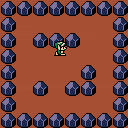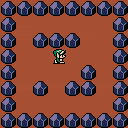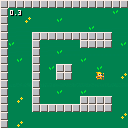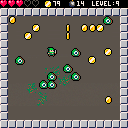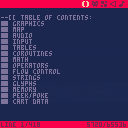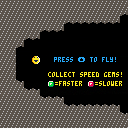Hello, everyone! I'm making a zine for an upcoming PICO-8 workshop I'm doing with Portland Indie Game Squad (PIGSquad). It's a fairly large zine (72 pages) and I have a few open pages where I wanted to include screenshots and art from some of the amazing things you all have created.
Do you have something you'd like to contribute?
If so, feel free to either post it as a reply on this thread, reply to this post on Twitter, or DM it to me on Twitter. (I have open DMs, so no need to follow me to DM me.)
The zine will printed in color for all workshop attendees, but will also be available on itch.io in PDF form once it is completed. (After the workshop, I may do a second printing at-cost via Kickstarter if there's enough interest from the community.)
Thanks in advance. The work you all do in PICO-8 is so incredibly inspiring to me, so I'd love to include some of it in this zine and inspire others who read it.

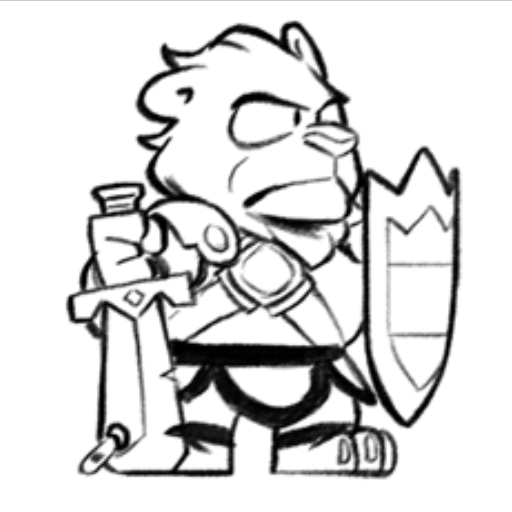









This is just a demo of some code to allow walking in tile-sized increments. The hook is that after player input, the player keeps walking until they reach the next tile.
In the first example, the walking tiles are 8x8, though the world is drawn with 16x16 tiles. The hitbox of the player is also only his lower half. This allows the player to be "in front" of things. Walk up to the bottom side of a boulder and walk left and right to see what I mean.
In the second example, the walking tiles are 16x16. The hitbox of the player is also 16x16, meaning the player can only occupy a single 16x16 tile, and can never be "in front" of other tiles.



I got a lot of comments about my smooth camera transitions in a recent WIP that I posted. I thought I'd just go ahead and share how I did it with a code sample cart. I'm posting the important function below, but feel free to look at the cart's code to see how it's implemented. I'm not a wizard, and I know it could probably be simplified somehow, so feel free to use and improve as you see fit. If you do improve it, let me know here so I can update the code for others to see!
function smooth_cam(spd) cam_x+=(flr(p.x/128)*128-cam_x)*spd cam_y+=(flr(p.y/128)*128-cam_y)*spd if (abs(cam_x-flr(p.x/128)*128)<0.5) cam_x=flr(p.x/128)*128 if (abs(cam_y-flr(p.y/128)*128)<0.5) cam_y=flr(p.y/128)*128 camera(cam_x,cam_y) end |


This was fun to make. I added a bunch of juicy stuff I usually do in Unity just for fun. The code is heavily commented and more verbose than it necessarily needs to be, because I wanted to make it easy to pull apart for people less familiar with making stuff in PICO-8. I'll keep adding stuff over time, but figured I'd release it as it is so far.
My highest score so far is 232. What's yours?
UPDATE: Added a possibility of slimes dropping a heart if you blow them up.



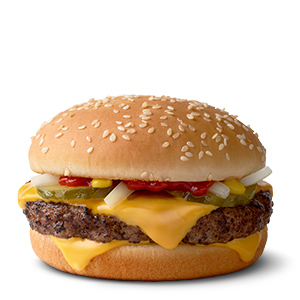
NOTE: There's nothing to "play" in this cart! It's all in the cart's code!
I remember reading a thread a while back about the idea of having the manual for PICO-8 available in the console itself, maybe in cart form. I plan on getting a PocketC.H.I.P. and I really want to have the whole API reference available to me right from inside PICO-8. So I decided to just put it all in a cart to always have a reference with me.
I made a lot of use of Neko250's awesome API cheatsheet, which is why he's credited as well as zep. I'm sure there are probably typos to correct and maybe an error here and there, so let me know if you see anything needing fixing. I'll try to keep it up to date. In the meantime, feel free to use it yourself.


These are variations of the rnd() function, but these return integers. You can either give just a maximum value or an arbitrary minimum and maximum value. You can also choose whether you want the maximum value to be exclusive or inclusive.
--random int between 0,h function rand(h) --exclusive return flr(rnd(h)) end function randi(h) --inclusive return flr(rnd(h+1)) end --random int between l,h function randb(l,h) --exclusive return flr(rnd(h-l))+l end function randbi(l,h) --inclusive return flr(rnd(h+1-l))+l end |











 20 comments
20 comments

